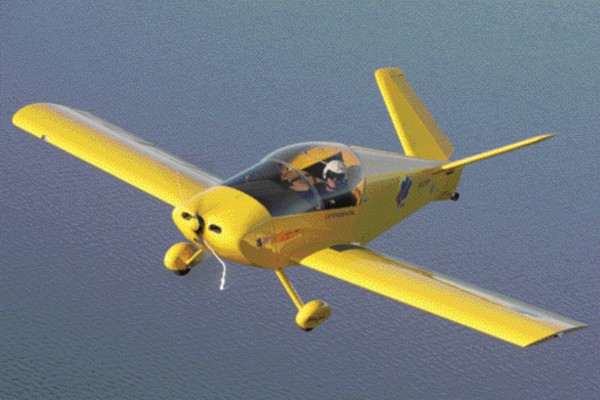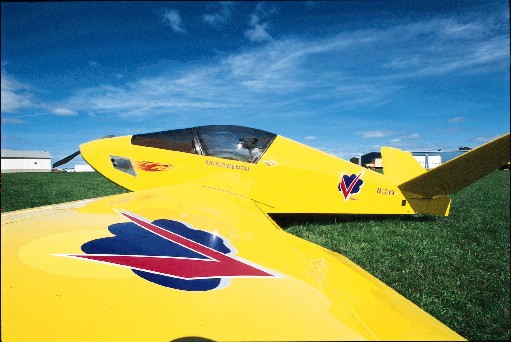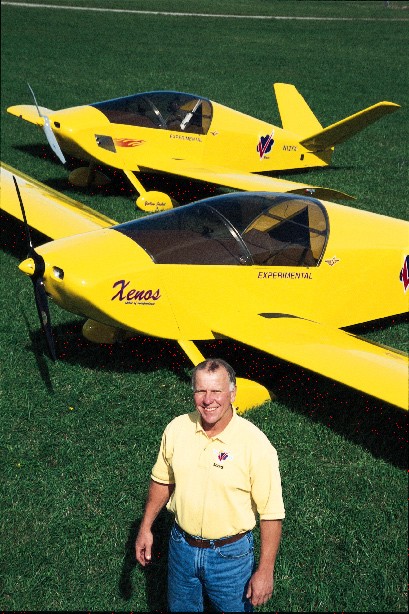
John Monnett demonstrates the Waiex over Wisconsin’s Lake Winnebago, a familiar landmark for anyone who’s flown to Oshkosh AirVenture.

Raring to go is one way to describe the lively
Waiex. This particular one has acquired
the nickname Yellow Jack.

The Waiex gets its name from its Y-tail: a
pair of surfaces called ruddervators to handle
pitch and yaw control as well as a stub
rudder (inset), which moves in concert with
the appropriate rudder pedal movement.

Designer John Monnett actually conceived
the ideas for the Xenos motorglider (front)
and Waiex prior to the Sonex, which the
company has offered for seven years.

The demonstrator Waiex is powered by an
80-hp AeroVee engine; using this flexible
dipstick, you can check for oil without having
to open any cowling doors.

Aside from the Y-tail, everything else on the Waiex is identical to the Sonex, the company’s better known kit airplane.

Flying the Xenos
Pedal to the Metal
The Y-Tail Waiex combines unusual style with refreshing speed.
The airlines may be suffering and
Light-Sport Aircraft (LSA) has yet to
coalesce into a coherent industry
segment, but Sonex Ltd. is having a fine run
of business. During my visit on a beautiful
fall day in Oshkosh, Sonex said it was ready
to break ground on a new hangar, the third
building of what has become the Sonex
campus on Wittman Field. At press time, it
was nearly complete.
Sonex is clearly ready for LSA, but
the company has built its enterprise on
delivering kits to the Experimental/ Amateur-
Built community. Steadily selling kits
keeps Sonex in good business shape while
LSA comes into focus. This company is well
positioned for whatever future recreational
flying holds.
$22,260. That calculates to an amazing $148
per mph.
Most of us don’t think in terms of
dollars per mph-and the comparison
with the RV-9 ignores the fact that
the RV is larger, heavier and, as a result,
more cross-country capable-but it
certainly proves that the Monnett machine
won’t take too much of your money for the
speed it can deliver. Add this to the mixture:
the kit has been optimized in many ways,
with laser-cut panels, much prefabricating,
jigless construction and factory builder
seminars that discount the kit enough to
make travel to Oshkosh worthwhile.
You can also choose between tricycle
or conventional gear. The wings remove easily
for transport. All major components are
built of familiar, easily worked, inexpensive
6061 aluminum.
If Light-Sport Aircraft is the direction
you want to go, here’s some good news: all
the Sonex machines qualify. You’ll have to
use a different prop on the Sonex and Waiex,
but they can then meet all the parameters
of FAA’s rule. The Xenos further qualifies as
a motorglider for which the FAA requires
neither an aviation medical nor a
driver’s license.
One way Sonex keeps down the cost
of its models is to offer two engine choices.
One is the Australian-produced Jabiru. The
four-cylinder, 80-hp 2200 model costs about
$10,000, close to a $2000 savings over the
80-hp Rotax 912 (and the 100-hp Rotax 912S
is about $3000 more). For about $14,000,
you can go with the six-cylinder, 120-hp
Jabiru 3300. This is more power, however,
than you’ll need if you choose to stay within
the speed limit of the LSA category.
But the best powerplant bargain is
the AeroVee kit engine. This son-of-a-Volkswagen
dual-ignition powerplant starts
easily, runs at engine revolutions familiar
to most general-aviation pilots and costs a
modest $5695. I repeat that it is a kit-you
get a DVD and/or video to help guide you
through the assembly process-but this is
certainly a way to keep the price tag from
spiraling out of control. Incidentally, Sonex
is the worldwide distributor for AeroConversions,
manufacturer of the AeroVee.
At a time when some high-end LSAs
are on the market for close to $90,000, Sonex
is doing the sport flying community a great
service by selling a worthy series of aircraft at
highly affordable prices.
Let’s Fly the Waiex
After Monnett thoroughly twisted my arm
(yeah, right!), I decided it was time to go
aloft. He rolled the Waiex out using his clever
tailwheel tow rig. It grasps the tailwheel
axle and lifts it a few inches off the ground.
Either Monnett has been hitting the Nautilus
machine or this rig helps move the Waiex
(and all other Sonex taildraggers) pretty
easily.
Our evaluation airplane was equipped
with the 80-hp AeroVee engine. Pipes left the
fuselage amid flame decals. It has a Beetle
sound to it, which may warm the hearts of
some previous owners.
We hopped in and closed the canopy
latch using a safety pin for additional security.
Before the engine start and runup, we
placed the brake lever in its park position.
The AeroVee uses a redundant, solid-state
ignition system independent of the electrical,
and it was checked on the first switch
position while an electronic system was on
switch position two.
Openings on each side of the canopy
draw in fresh air. They worked well even in
taxi, which is good because the aircraft’s
clear canopy offers no sun cover. It does,
however, make spotting traffic child’s play.
As soon as you start to taxi this
taildragger, you notice something
different, something less sloppy than is
often associated with tailwheel-steered
aircraft. Pay thanks to a solid linkage from
pedal to tailwheel, versus the more common
cable-to-spring linkages with their spongier
feel. This setup helps reduce the need for
the “dancing feet” technique needed to
land some tailwheel aircraft without getting
into a ground loop. With this solid linkage,
Monnett says, you operate the aircraft more
authoritatively. I liked it so much I wondered
why more designs haven’t employed this
method.
Because it’s a taildragger, you will
need to move the Waiex’s nose somewhat
for taxi visibility; the need wasn’t great,
however, as I could almost see directly forward
by moving my head. We taxied out
to the active at Wittman Field. (It always
seems strange to fly at this airport without
the torrent of activity I’m used to during Air-
Venture.) We were quickly number one-we
rolled onto the runway, straightened out
and opened the AeroVee’s throttle fully.
Waiex Is For Y-Tail
We can see you fighting the name with
all those vowels hung together. Don’t say
“WAY-ex.” Say “WHY-ex,” and the name immediately
makes sense. That may seem new,
but, except for its namesake Y-shaped tail,
everything else on the Waiex is identical to
the Sonex model the company has sold since
it began in 1998.
I flew the company’s bright yellow
Waiex with designer John Monnett. Many
earlier builders and enthusiasts know Monnett
for his Monerai, Moni, and Monex Racer,
all of which share the Y-tail. “The Waiex is
actually the airplane we had in mind even
before the Sonex,” Monnett told me.
In addition to a Bonanza-like
control system-on the splayed portions of
the tail, a pair of surfaces called ruddervators
handle pitch and yaw-the Waiex includes
a stub rudder at the furthest aft section of
fuselage that moves in concert with the
appropriate rudder pedal movement. Using
the fuselage this way is a Steve Wittman
design technique, Monnett said. It is a nice
touch from an aerodynamics viewpoint but
Acceleration was brisk, a credit to the
light weight of the aircraft. In a few hundred
feet, we rotated and left the ground. Takeoff
roll near maximum-gross weight is about
600 feet, Monnett indicated. While the Waiex
can zoom to pretty high speeds, it works well
at low speeds; we had lifted off at about 55
mph.
The Waiex trim system is different
partly owing to the Y-tail. A rotating knob
is fitted just to the left of the throttle, and it
sets a bungee cord system on the joystick.
In this way, the Waiex works like some ultralights
that also bungee-load the joystick to
provide relief to the pilot. By a rotating
motion, you adjust the center position of
the bungees. It may not sound as slick as a
trimtab, but it did the job.
As we flew around in slower flight
ranges, we explored the flap system. The
Waiex uses a two-position flap lever (15°
and 30°) plus a neutral position. On landings
later, I would find the second position to be
plenty; the aircraft does not need more flap
than it has.
But Monnett wanted to show off the
considerable speed of his Waiex. He also
wanted to go hunt for his son, Sonex General
Manager Jeremy Monnett, who was out
flying the Xenos. Being a soaring enthusiast
and hoping for a flight later in the long-wing
Xenos, I was equally interested in seeing the
motorglider in flight.
During the hunt, we relied on the
Stratomaster Ultra electronic information system,
which weighs less than 2 pounds. This
is an “ultralight industry” instrument from
South Africa that combines flight and engine
instrumentation and portrays the readings in
both digital and analog formats. (The system
costs around $2500 with the attitude module
and all sensors for a four-cylinder engine.)
Monnett had also installed a TruTrak Flight
Systems Digitrak autopilot, which weighs a
mere 5 pounds.
With Monnett next to me in the 40-
inch-wide cockpit, I found it a little crowded;
neither of us is particularly large. We were
touching slightly, and I was also bumping
the canopy. Two big fellows would be tight,
but as Monnett feels and as surveys have
revealed, most two-seat aircraft are flown
solo.
Gone Flying…Fast
Sonex says the maximum climb rate while
solo is about 1200 fpm, and the AeroVee
produced about 800 fpm near gross. During
climb, the tachometer was showing
about 3200 rpm. Since the engine noise
at this power setting was quite noticeable
on my tape recorder, I’d consider a headset
essential; I didn’t want to remove the one I
was wearing. At a density altitude of 3500
feet, while not much below the 1100-pound
maximum gross weight and flying at full
throttle (3400 rpm indicated), the airspeed
indicator showed 138 mph, LSA’s maximum
speed limit. Averaged runs back and forth
using a GPS readout verified the number.
The Waiex holds 17 gallons of fuel and
the AeroVee burns about 4 gph, so you have
3.5 hours of endurance even with reserves.
At a cruise of, say, 130 mph, that calculates
to a 450-mile no-wind range.
Slow flight with plenty of trim dialed
in indicated 60 mph at which the nose angle
was quite high. During the slow flight period,
the stick remained pleasant to use with light
control forces and good response. Despite the
additional area of the stub rudder, the pedals
felt much softer, much less authoritative
at this speed, where at high cruise the rudder
felt very powerful, facts John attributed
to the Y-tail.
Stall speeds were slightly lower than
dictated by LSA, that is, about 45 mph (the
rule is 45 knots or 52 mph). Stall behavior
was benign. A significant airframe quiver
foretold the stall onset with plenty of warning.
Power-on stalls produced steep deck
angles; it would be hard to miss stall entry if
you have a visual on the horizon. Accelerated
stalls also got to a high nose angle but rolled
cooperatively to level on stall break, which
was quite muted even when I stalled more
aggressively. During one exaggerated effort,
I managed to induce one wing to drop a bit,
but the resulting bank angle was not steep.
Recovery from any stall involved no more
than lowering the nose. Adding power is not
necessary, though perhaps advisable.
Is a Waiex In Your Future?
If what you’ve read interests you, follow up
with some further research. Sonex offers a
detailed literature package with informative
DVDs as well as another DVD production
titled “Right Seat with Tony Spicer,” (order the DVD and see a preview here). The company also holds builder
workshops a few times per year that give
you a chance to meet the factory staff, learn
about the construction of the airplanes and
build your confidence by actually completing
a piece of a Sonex wing.
So, no wonder Sonex is thriving: It’s
got the right combination of a fun-to-fly
design in the Waiex along with reasonable
prices, lauded factory support and straightforward
construction techniques.
| Seating | 2, side by side |
| Empty weight | 620 lb |
| Gross weight | 1,100 lb |
| Wingspan | 22 feet |
| Wing loading | 11.22 lb/sq.ft |
| Useful Load | 480 lb |
| Payload (with full fuel) | 384 lb |
| Cabin Interior | 40 inch |
| Fuel Capacity | 16 Gal |
| Baggage area | 50 lb |
| Standard engine | AeroVee 2180 |
| Prop Diameter | Sensenich 2 blade fixed-pitch |
| Power | 80 hp@3400 rpm |
| Cruise speed | 150 mph (130 kt) 8000 feet @ 75% power |
| Stall Speed (Flaps) | 40 mph (35 kt) |
| Stall Speed | 46 mph (40 kt) |
| Rate of climb at gross | 500 fpm (1,200 at aerobatic weight) |
| Takeoff distance at gross | 400 ft |
| Landing distance at gross | 500 ft |
| Fuel Consumption | 4 gph |
| Options | Engine: Jabiru 2200 Engine: Jabiru 2300 |


Leave a Reply